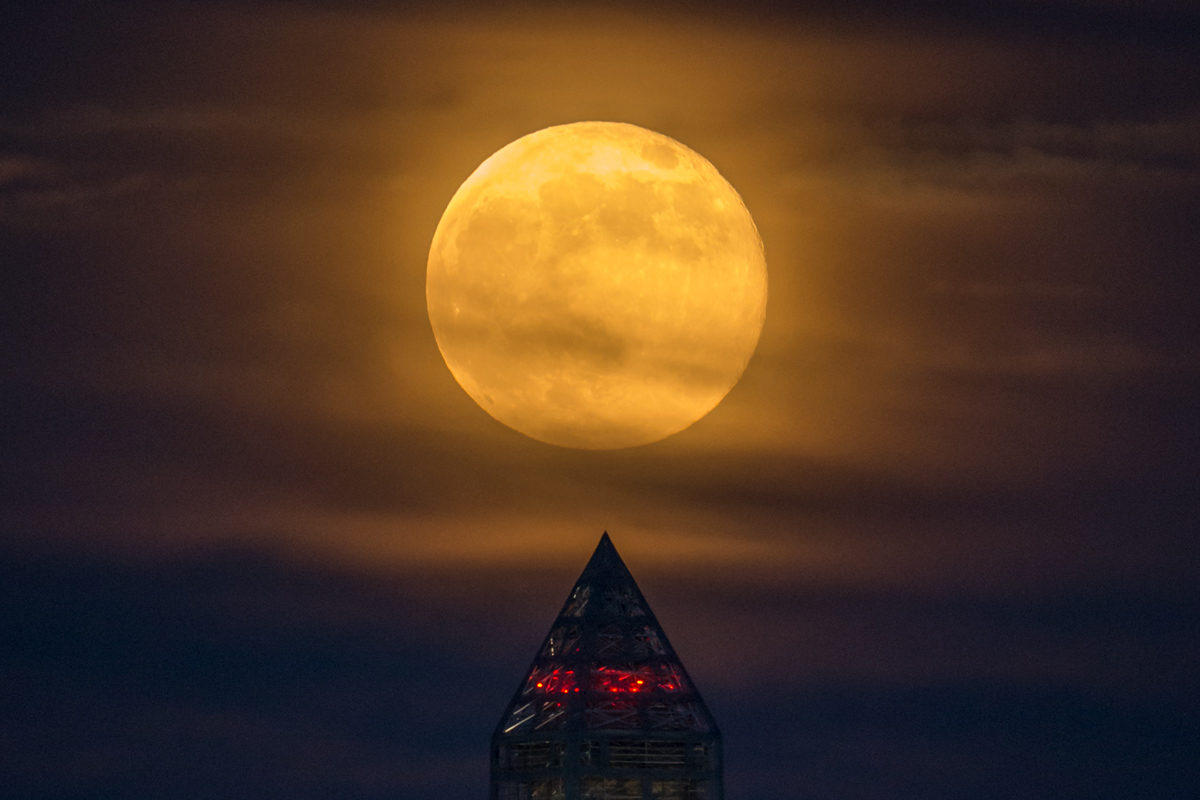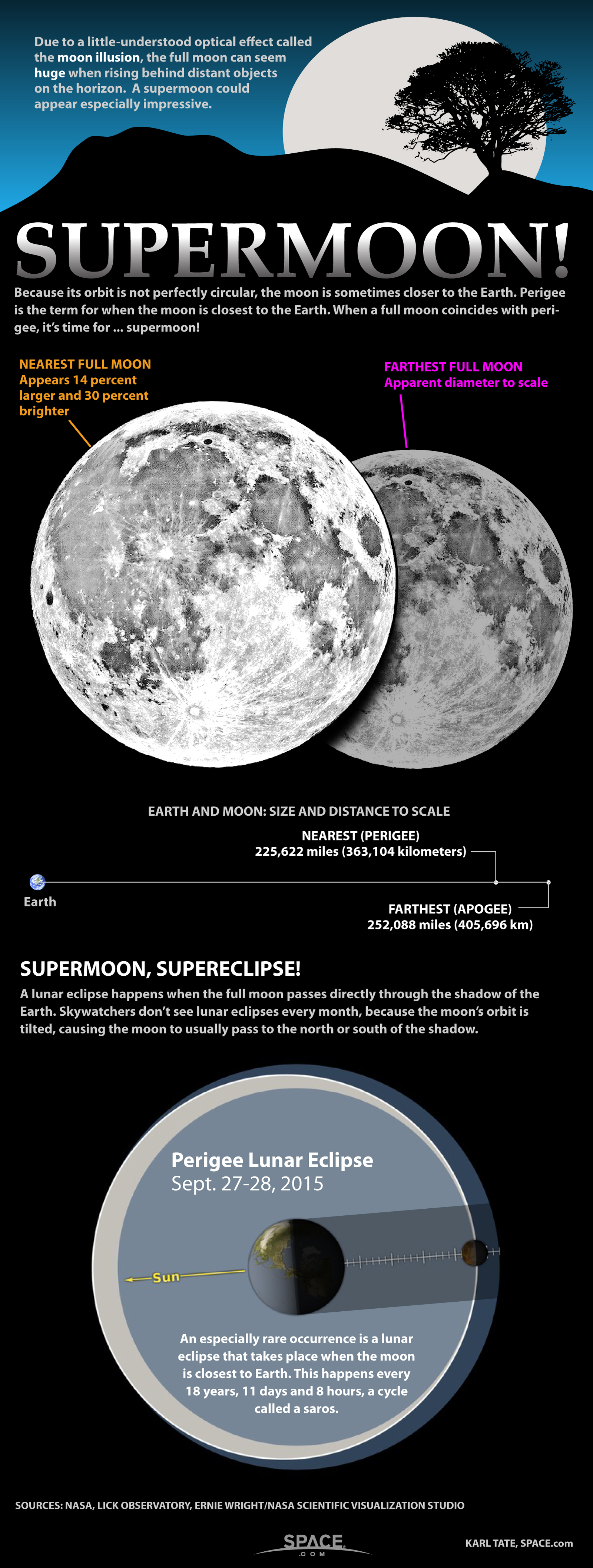New Year's Day Full Moon: Are 'Supermoons' Really That Super?
On this first day of 2018, at 5 p.m. EST (2200 GMT), the January full moon will arrive at perigee, its closest point to Earth in an orbit. Today, our lunar companion reaches an extreme perigee distance of 221,559 miles (356,565 kilometers). When these events coincide (a full moon at perigee), some people refer to the event as a "supermoon."
This will be the "biggest full moon of 2018," and the difference in the moon's apparent size, compared with when it is positioned at its average distance from Earth, will be 7.3 percent. But that variation is not readily apparent to observers who are viewing the moon directly.
And then there is the other facet: the oft-cited statistic that the perigee full moon is 30 percent brighter than a "normal" full moon. But that translates to only a 0.1 or 0.2 magnitude difference in brightness. When added to the glow of a full moon, the difference is hardly perceptible to the human eye. (In fact, most observers can't discern a truly "full" moon from a nearly full moon, and for a day or two before and after peak fullness, many people who see the moon will assume it is full.) [Supermoon 2018 Guide: When and How to See January's Two Full Moons]
Put another way, if you didn't hear that the New Year's Day full moon was going to be the biggest and brightest one of the year, would you notice it? Probably not.

You can watch webcasts of January's New Year's Day supermoon live today and tonight. First, the Virtual Telescope Project by astrophysicist Gianluca Masi will host a free webcast of the full moon rising over Rome, Italy at 11 a.m. EST (1600 GMT). You can watch that webcast live here.
At 9 p.m. EST (0100 GMT), the online observatory Slooh.com will offer a live webcast from its remotely operated telescopes around the world. You can watch the Slooh supermoon webcast here, though registration for the website - which is free - is required.
Get the Space.com Newsletter
Breaking space news, the latest updates on rocket launches, skywatching events and more!
You can also watch the January supermoon webcast on Space.com here, courtesy of Slooh.com.

Bigger … brighter … or just hyperbole?
Most media outlets love to treat a "supermoon" as some sort of special or unusual occurrence. Upon hearing that a specifically selected moon comes with the prefix "super" attached, people rush outside to get a look and come away thinking that they have just witnessed something akin to a rare cosmic alignment. Such feelings put a new spin on the whimsical tale penned in 1837 by Hans Christian Andersen, "The Emperor’s New Clothes."
In fact, I once took a phone call at New York's Hayden Planetarium from a young woman who sounded as though she had been cheated. "I went outside last night to look at that so-called 'super' moon and was very much disappointed. It didn't look at all brighter than normal." When I queried her on what she had expected to see, she replied, "I thought it was going to be something like those three-way light bulbs. Like when you go from 100 to 150 watts; I thought the moon was going to appear noticeably brighter last night, but it really wasn't at all!"
Of course, once somebody is told that the moon is closer than normal to Earth and that it will consequently appear somewhat larger, they might respond with something like, "Oh yeah! It does look bigger than normal!" This is especially true if someone sees the moon near to the horizon, where the enigmatic "moon illusion" always comes into play.
A supermoon every month?
If the criteria for a supermoon is chiefly dependent on the moon's arrival at its closest point in its orbit relative to Earth, then the "super" branding is a bit of a misnomer. Indeed, the moon arrives at perigee every month and sometimes twice in a calendar month. Indeed, now the full moons that immediately flank the Jan. 1 perigean full moon are also being branded as supermoons. The full moon on Dec. 3 was "super," and the one later this month, on Jan. 31, will be, too. And the margin for a supermoon seems to be widening, as full moons that occur within one or two days of perigee are sometimes given the "super" moniker.
So why can't we have a supermoon at other phases? This year on Halloween, for instance, the last-quarter moon will come within less than 4 hours of perigee. But nobody ever gets excited about a "super" half-moon.
The popular astrophysicist Neil deGrasse Tyson probably said it best: "In the overall scheme of things, is this relatively small increase in the moon's apparent size really so meaningful? I mean, if you turned a 14-inch pizza into a 15-inch pizza, would you then call it a "super-pizza?"
Maybe when it comes to our natural satellite, size doesn't really matter after all.
Editor's note: If you capture an amazing photo of the Jan. 1 New Year's Day supermoon and would like to share it with Space.com for a story or gallery, send images and comments to: spacephotos@space.com.
Joe Rao serves as an instructor and guest lecturer at New York's Hayden Planetarium. He writes about astronomy for Natural History magazine, the Farmer's Almanac and other publications, and he is also an on-camera meteorologist for Verizon Fios1 News, based in Rye Brook, New York. Follow us @Spacedotcom, Facebook and Google+. Original article on Space.com.
Join our Space Forums to keep talking space on the latest missions, night sky and more! And if you have a news tip, correction or comment, let us know at: community@space.com.

Joe Rao is Space.com's skywatching columnist, as well as a veteran meteorologist and eclipse chaser who also serves as an instructor and guest lecturer at New York's Hayden Planetarium. He writes about astronomy for Natural History magazine, Sky & Telescope and other publications. Joe is an 8-time Emmy-nominated meteorologist who served the Putnam Valley region of New York for over 21 years. You can find him on Twitter and YouTube tracking lunar and solar eclipses, meteor showers and more. To find out Joe's latest project, visit him on Twitter.









